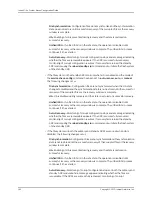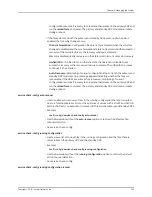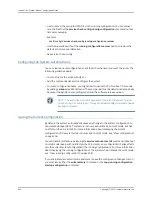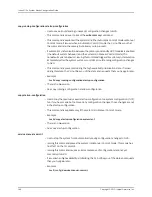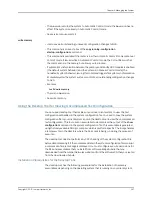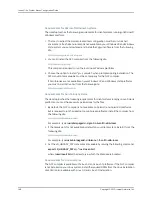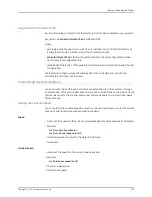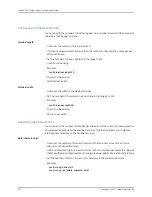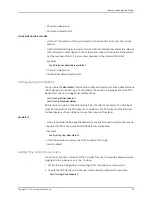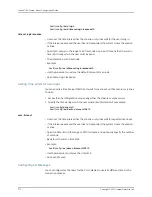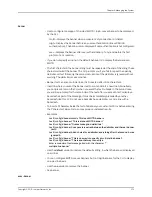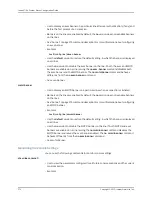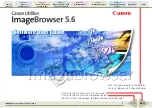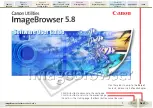
Sending Messages
You can send a message to one or more terminals with the
send
command. You can
specify a line number, a console number, or a vty number. You can also send the message
to all terminals.
The following command sends the message “ hello console” to line 0:
host1#
send 0 “ hello console”
The following command sends the message “ hello everyone” to all terminals:
host1#
send * “ hello everyone”
If you begin the message on the same line as the
send
command, the first character of
the message is considered to be a delimiter. You must use the same character to terminate
the message. In both examples above, the delimiter was a double quotation mark (
“
).
If you press Enter without typing the second delimiter, the CLI prompts you for more
message text and reminds you to complete the message with the delimiter, as shown in
the following example:
host1#
send vty4 XYou can start a message on the same line
Enter remainder of text message. End with the character 'X'.
and continue it on subsequent lines; the CLI prompts you for
Enter remainder of text message. End with the character 'X'.
more message text until you enter the second delimiterX
Proceed with send? [confirm]
If you do not begin the message on the same line as the
send
command, the CLI prompts
you for the message text after you press Enter. The CLI does not recognize delimiters for
these messages; you must enter Ctrl+z, as shown in the following example:
host1#
send 0
Enter remainder of text message. End with ^Z.
Good morning, Major Tom
^Z
Proceed with send? [confirm]
The receiving terminals display the message without regard to other output currently
displayed on the terminal. Pagination is not affected.
The sending terminal is not affected by the state of the intended receiving terminal. For
example, if the receiving terminal is flow-controlled off or at a --More-- prompt, the
message is still sent, and the sending terminal is available for further commands. The
receiving terminal in this case displays the message when subsequently flow-controlled
on or when the user responds to the --More-- prompt.
The receiving terminal displays the message, the line number of the sender, the username
of the sender if the user was authenticated through RADIUS, and the time the message
was sent.
send
Copyright © 2010, Juniper Networks, Inc.
276
JunosE 11.3.x System Basics Configuration Guide
Summary of Contents for JUNOSE 11.3
Page 6: ...Copyright 2010 Juniper Networks Inc vi...
Page 8: ...Copyright 2010 Juniper Networks Inc viii JunosE 11 3 x System Basics Configuration Guide...
Page 24: ...Copyright 2010 Juniper Networks Inc xxiv JunosE 11 3 x System Basics Configuration Guide...
Page 32: ...Copyright 2010 Juniper Networks Inc 2 JunosE 11 3 x System Basics Configuration Guide...
Page 146: ...Copyright 2010 Juniper Networks Inc 116 JunosE 11 3 x System Basics Configuration Guide...
Page 166: ...Copyright 2010 Juniper Networks Inc 136 JunosE 11 3 x System Basics Configuration Guide...
Page 432: ...Copyright 2010 Juniper Networks Inc 402 JunosE 11 3 x System Basics Configuration Guide...
Page 488: ...Copyright 2010 Juniper Networks Inc 458 JunosE 11 3 x System Basics Configuration Guide...
Page 524: ...Copyright 2010 Juniper Networks Inc 494 JunosE 11 3 x System Basics Configuration Guide...
Page 554: ...Copyright 2010 Juniper Networks Inc 524 JunosE 11 3 x System Basics Configuration Guide...
Page 566: ...Copyright 2010 Juniper Networks Inc 536 JunosE 11 3 x System Basics Configuration Guide...
Page 588: ...Copyright 2010 Juniper Networks Inc 558 JunosE 11 3 x System Basics Configuration Guide...
Page 613: ...PART 3 Index Index on page 585 583 Copyright 2010 Juniper Networks Inc...
Page 614: ...Copyright 2010 Juniper Networks Inc 584 JunosE 11 3 x System Basics Configuration Guide...
Page 632: ...Copyright 2010 Juniper Networks Inc 602 JunosE 11 3 x System Basics Configuration Guide...

